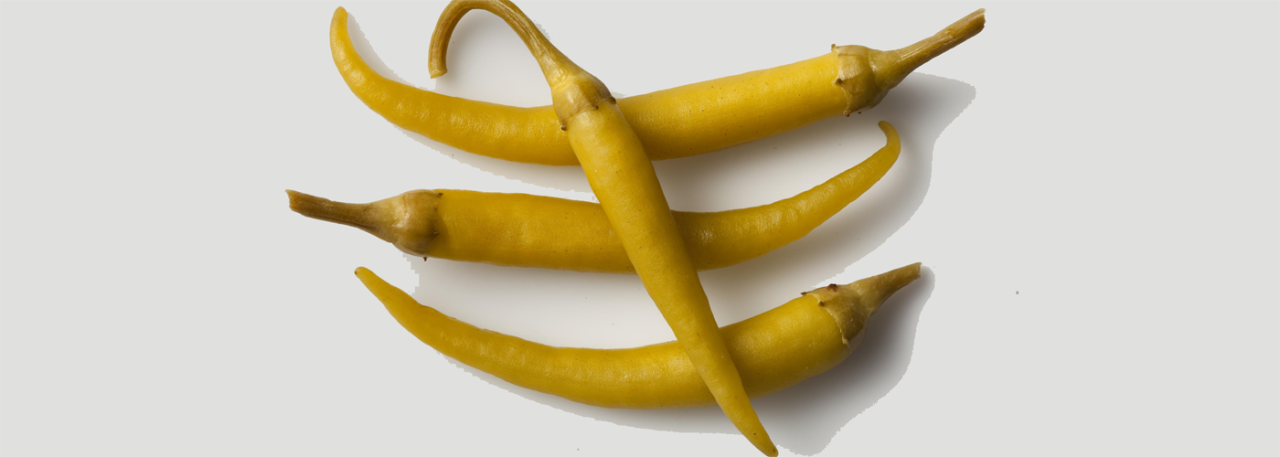.png.transform/rendition-xs/image_image%20(1).png)
Guindilla de Ibarra (Ibarrako Piparrak)
Guindilla de Ibarra is the name given to a variety of chilli pepper which is grown and processed mainly in the Basque Country (Guipúzcoa). It is either green or greenish-yellow, and has a narrow elongated shape and varying length, generally around 3.94 in / 10 cm. It takes its name from the Basque town of Ibarra, and is also known as Langostino de Ibarra (Ibarra king prawn). It is consumed as a pickle and it is also used to make the cocktail sticks known as banderillas in combination with other pickles.
The Guindilla de Ibarra is today recognized within the scope of the Basque Country with the Basque Food Quality stamp (Eusko Label Kalitatea), which is awarded by the Kalitatea Foundation; its production is therefore regulated by specific guidelines of a regional nature. The Kalitatea Foundation is a private organization created by the Department of Agriculture and Fisheries of the Basque Country.
Tasting notes
It is mild, not excessively hot, and has tender flesh and a fine skin.
Other notes
The Guindilla de Ibarra has a peduncle or narrow elongated stalk. It is not at all hot, and has a smooth, narrow, elongated shape, and a round section. The color is an even yellowish green with a slight shine.
The following regulatory criteria are established for products in the brand Ibarrako Piparrak - Guindillas de Ibarra with the Eusko Label stamp:
- Narrow elongated fruit, whole and firm, with a round section and the typical thickness of the walls of this variety.
- Yellowish green with a slight shine and even coloring.
- Sharp, slightly curved apex.
- Peduncle, whole, fine and long.
- Fine unbroken skin.
- Tender texture.
- Fresh unwrinkled appearance.
- Length of the edible part, between 1.97 in and 4.72 in / 5 and 12 cm.
Production / Processing method
The chilli peppers are planted between April and May, and are harvested between June and October.
Any kind of treatment must be in response to a particular problem which arises, and using products which can be rapidly eliminated and are environmentally friendly. In this case, the harvesting must be done after a period of suppression and at the optimum point of development of the product, always taking care not to damage the pepper. The Foundation establishes a list of authorized treatments at the start of every season.
The peppers are cured with a solution based on wine vinegar and salt, and in the case of products protected by the Basque quality stamp, this liquid must have the following characteristics:
- The main component of the basic liquid is diluted wine vinegar.
- The pH of this liquid must be between 3.3 and 3.6.
- It contains a maximum of 10 g of salt per liter.
- Given the product's consideration as an sharp pickle owing to the use of wine vinegar as the base liquid, the concentration of sugar measured in Brix degrees must be between 3.5 and 4.5.
The regulation recognized by the Eusko Label for the packaging process for the Guindilla de Ibarra specifies that the content must have a homogeneous coloring, variety and caliber. The packaging used must not contain any trace of withered leaves or soil residues, or any extraneous matter. It must also be hermetically sealed in such a way as to protect the product and ensure that it can be easily seen. The packaging must be tamperproof. After a minimum of 20 days the packaging is labeled. It is important to note that it cannot be labeled before this period, as it is necessary to verify that the characteristics of the product in the packaging conform to the regulation. Similarly, no more than 30 days should elapse between the packaging process and the time the product leaves the plant. The expiry date is a maximum of two years from the date of packaging. The handling, packaging and commercialization of this product can only be done in registered packaging centers in the Basque Country, as well as in plants registered with Eusko Label.
Geography / Relief and climate
This regulation specified by the Eusko Label stamp establishes the cultivation areas in the Basque Country: low-lying land (below 1476.38 ft / 450 m), mild temperatures, high humidity and rainfall.
The Basque Country borders on the Cantabrian Sea and France to the north, the regions of Cantabria and Castile-León to the east, Castile-León and La Rioja to the south, and Navarre to the west. It is located in the easternmost part of the Cantabrian Coast of the Iberian Peninsula.
It has an area of 7,235 km2 and is divided into three provinces: Álava (3,037 km2), Vizcaya (2,217 km2) and Guipúzcoa (1,980 km2). Due to its location it is divided into two areas –known as the Atlantic and the Mediterranean faces– with the separation marked by mountain ranges (Aralar, Aizkorri and Gorbeia). This difference in climate leads to marked changes in landscape: mountains, valleys, plains, coast, etc.
The area on the Atlantic face is mountainous, as the Pyrenees come down practically to the sea. The coast of Guipúzcoa and Vizcaya is steep with numerous capes, islands and estuaries. In contrast, in Lapurdi the coast is gentler.
The region of the Basque Country is located at an altitude of between 1978.35 ft and 5088.58 ft / 603 m and 1,551 m, although most of the territory is below 4265 ft / 1,300 m. The average temperature ranges from between 43.16ºF / 6.2ºC (the average minimum temperature) and 65.84ºF / 18.8ºC (the average maximum temperature). In winter are the absolute minimum temperature ranges from 31.1ºF to 20.12ºF / -0.5ºC to -6.6 ºC in the highest parts. The absolute maximum temperature is between 69.2ºF and 100.5ºF / 20.7ºC and 38.1ºC.
The peppers are cured with a solution based on wine vinegar and salt.

